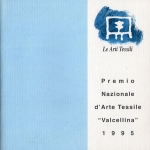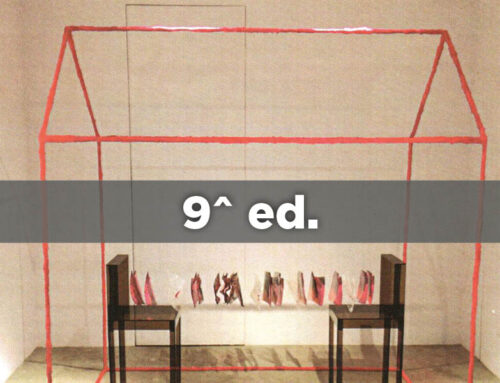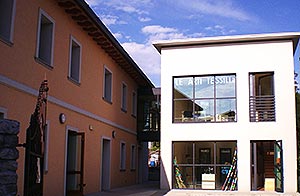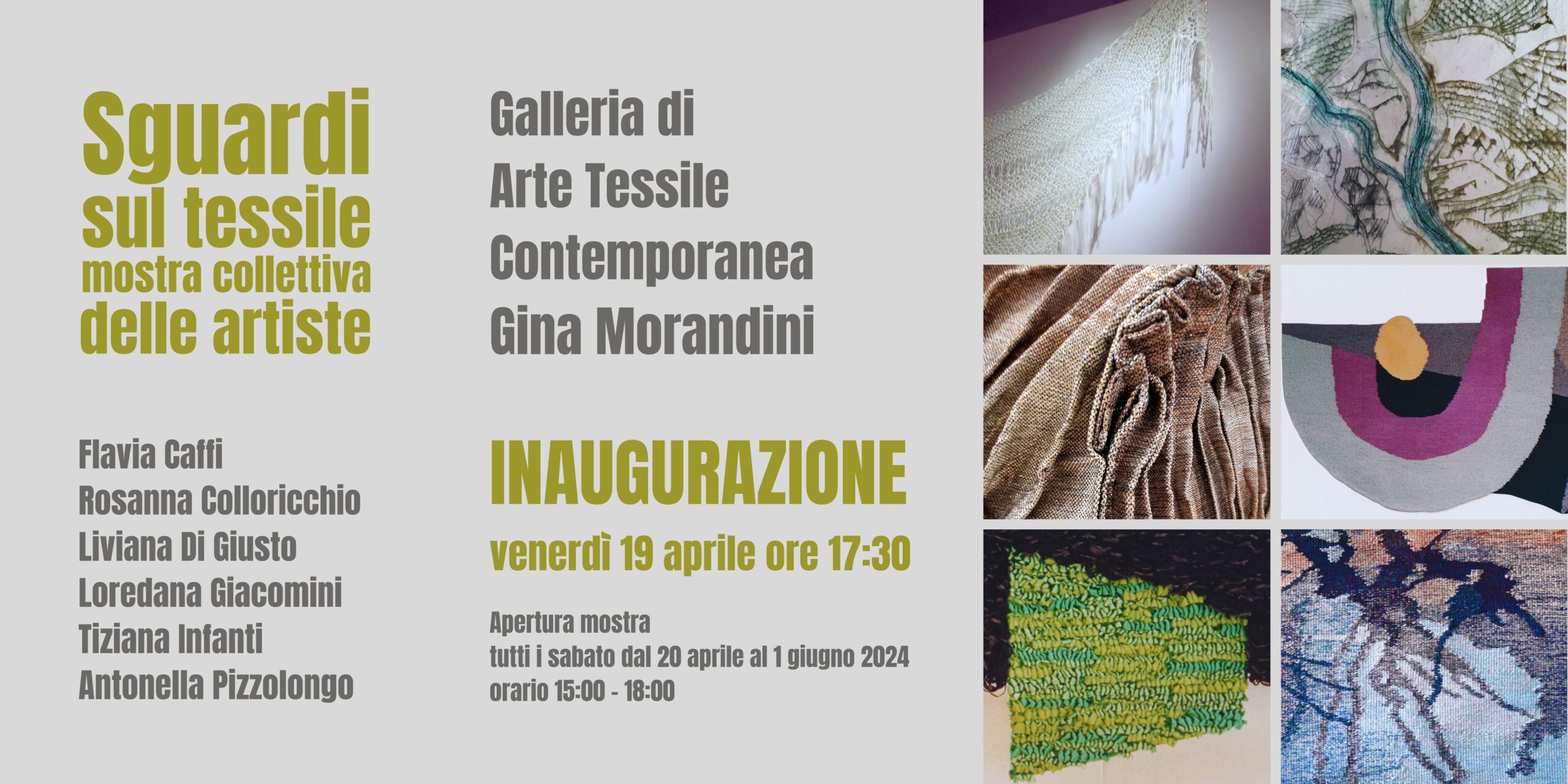1995-1996
Premio Nazionale d’Arte Tessile Valcellina, 1^ edizione
Valcellina National Textile Art Award, 1st edition
Concorso rivolto a tutti i giovani artisti tessili di età inferiore ai 30 anni, residenti in Italia
Competition open to all young fiber artists resident in Italy and under 30 years of age
Chiusura del bando 30 settembre 1995
Artisti 51 partecipanti, 33 selezionati ammessi al concorso
Inaugurazione e cerimonia di premiazione 14 gennaio 1996, Ex-Filanda, Maniago PN
Durata dell’esposizione dal 15 gennaio al 28 febbraio1996
Appuntamenti successivi Dal 5 al 20 giugno 1996, la mostra è stata trasferita al Museo Nazionale delle Arti e Tradizioni Popolari, Roma in collaborazione con il Centro Italiano per lo Studio della Storia del Tessuto
Deadline for participation 30 September 1995
Artists 51 participants, 33 selected and admitted to the competition
Inauguration and award cermony 14 January 1996, Ex-Filanda (Ex-Spinning mill), Maniago PN
Exposition period from January 15th to February 28th, 1996
Subsequent events From June 5th to 20th 1996, the exhibition was transferred to the Museo Nazionale delle Arti e Tradizioni Popolari (National Museum of Popular Arts and Traditions), Rome in collaboration with the Centro Italiano per lo Studio della Storia del Tessuto (Italian Center for the Study of the Textiles History)
Giuria / Jury
Gina Morandini – Presidente Associazione Le Arti Tessili / President of Le Arti Tessili association
Lydia Predominato – Artista tessile / Textile artist
Irmgard Rapp – Corrispondente Textile Forum di Hannover, Germania / Correspondent Textilforum, Hannover, Germany
Giorgio Segato – Critico d’arte / Art critic
Jorrit Tornquist – Docente di Teoria del Colore presso Politecnico di Milano, Italia / Lecturer: Colour Theory, Politecnico di Milano, Italy
Artisti selezionati, opere e premi assegnati
Selected artists, works and prizes awarded
PRIMO PREMIO / FIRST PRIZE
Barbara Salato Divenire di un passo riflesso tra giochi di luci e trasparenze/ The become of a reflected step between games of light and transparency
SECONDO PREMIO / SECOND PRIZE
Cristiano Carciani Lunga vita al manichino / Long live the dummy
TERZO PREMIO / THIRD PRIZE
Eleonora Milesi La spesa è uguale per tutti / Everyone pays the same price
PREMIO SPECIALE / SPECIAL PRIZE FRIULI VENEZIA GIULIA
Mariagrazia Bernardis Donna mostruosa / Monstrous woman
MENZIONE SPECIALE / SPECIAL MENTION
Maria Cristina Mancinelli A casa / At home
MENZIONE SPECIALE / SPECIAL MENTION CIRCOLO CULTURALE MENOCCHIO
Lucia Pagliuca Le colonne / The columns
–
Katiuscia Albanese Omaggio a Klimt / Homage to Klimt
Giovanna Barbieri Dove ha perso la testa Maria? / Where has Maria lost her head?
Lorenza Boisi Riconversione di memorie / Converting memories
Lucia Capri Metamorfosi / Metamorphosis
Angela Casaril Caragol / Caragol
Patrizia Casini Armonia di contrasti / Harmony of contrasts
Kerry Trevi Dolphin Vite riparate / Sheltered lives
Linda Donati … Come esuli pensieri … / … As exiled thoughts …
Monica Dreossi La libertà / Freedom
Vania Falcomer Senza tempo / Timeless
Lorenza Gaiardi Arazzo / Tapestry
Enrica Giubellini Poseidonia / Poseidonia
Massimo Lattanzio Materia / Substance
Amarilli Lerzio Fusione / Fusion
Barbara Lerzio Umanità / Humanity
Federica Luzzi Senza titolo / Untitled
Evelina Marconi Alga magica / Magical seawood
Daniela Mazzucco Ein schloss in un paradiso di lana / A Castle in a woollen paradise
Carmela Milazzo Il viandante / The wayfarer
Daniela Negro Arcobaleno / Rainbow
Valentina Ottone La linea del cuore / The heart line
Alessia Padoan L’esatto contrario / The exact opposite
Silvio Pin Tensione / Tension
Roberta Piva L’albero della vita / The tree of life
Nadia Pomposi La natura vista attraverso il tessuto / Nature seen through fabric
Lucia Sellan Fylla / Fylla
Antonella Tana Valverdi Omaggio al Messico / Homage to Mexico
Saggio critico / Critical essay
L’Arte Tessile, La Vita, Il Pensiero di Giorgio Segato, critico d’arte, giuria Premio Valcellina 1^ edizione
Penelope: l’attesa, la trama, l’ordito, la vita, il pensiero, l’inganno, il farsi e il disfarsi; l’accumularsi e il decantarsi di esperienze, ricordi, impressioni; l’intrecciarsi e lo strutturarsi del filo in filo logico, in forma, in atto creativo; l’emergere della memoria, il coniugarsi di passato e presente, e il desiderio, la nostalgia progettuale di futuro. L’arte tessile mi fa pensare a tutto questo. E l’aver partecipato ai lavori della qualificata Giuria del Premio Nazionale Valcellina -1995, con Irmgard Rapp, Lydia Predominato, Gina Morandini e Jorrit Tornquist, ha ancora più rafforzato nella mia esperienza di critico d‘arte l’idea che nell’arte tessile e insita una delle più alte metafore del farsi della vita come logos, pensiero, discorso, progetto, comunicazione. Di qui risulta evidente l’importanza straordinaria che l’esercizio di quest’arte riveste come particolare manifestarsi della creatività e come eccellente disciplina formativa e didattica: il rapporto diretto con i materiali, l’elaborazione delle combinazioni delle texture in senso compositivo, tattile, cromatico, plastico, l’infinita possibilità di strutturazioni, i tempi e i modi tecnici di una manualità che costantemente impara e riflette, pensa e costruisce, immagina e traduce nella materia costituiscono tutti i “valori” sostanziali di un’attività che ha espresso ed esprime livelli altissimi di arte pura e altissimi livelli di artigianato artistico, confrontando costantemente ricerca e produzione funzionale, tradizione e innovazione.
Il concorso Valcellina ha ben rispecchiato questa condizione bifronte, per quanto, come tutte le arti manipolate, anche l’arte tessile correttamente intesa denunci sintomi assai gravi di abbandono e di dimenticanza, di perdita. L’iniziativa dell’Associazione Le Arti Tessili col suo Centro di Attività Culturali, Studi, Informazioni, acquista ancor più alti meriti promozione artistica e culturale poiché, da una parte insiste nella rivalorizzazione di un’espressione d’arte in cui certamente sono intrecciate in modo indissolubile le radici della nostra memoria artistica più profonda, dall’altra si apre a innovazioni, proposte, soluzioni capaci di accentuare l’incidenza degli aspetti progettuali e più squisitamente creativi sul mestiere, sullo specifico dell’arte. L’esito dell’iniziativa è ben visibile a tutti nella premiazione che ha evidenziato un’ampia gamma di aspetti: dalla ricerca più libera di tessiture di luce alla provocazione concettuale, dalla strutturazione di trame e orditi in organizzazioni plastico-architettoniche o in modulazioni in qualche modo scultoree.
Ma numerose sono le suggestioni forti che la Mostra riserva, con un uso della tessitura ad ampio orizzonte: dalle didattiche operative alle elaborazioni squisitamente tecniche, dalla proposta monumentale all’invenzione di volumi di forte suggestione organica con accese cromie, dalla costruzione di veri e propri paesaggi tridimensionali alla modulazione lirica astratta del colore come forma e contenuto dell’emozione esistenziale.
Textile Arts, existence, ways of thinking by Sergio Segato, art critic, jury member of Valcellina Award 1st edition
Penelope: expectation, warp and weft, existence, ingeniousness, beguilement, creating and unravelling; accumulating and decanting experiences, memories and impressions; intertwining and organising the threads into logical strands, into form, in the act of creating; the emerging of memory, the conjugation of past and present, and desire, the nostalgic blueprint of the future. Textile art compels me to ponder all of these things, and having taken part in the work of the distinguished Jury of the “Valcellina 1995” National Award along with Irmgard Rapp, Lydia Predominato, Gina Morandini and Jorrit Tornquist, the idea is futher affirmed, that textile art is intrinsically one of the paramount metaphors for the “creating” of (ones) life as rationale, thought, discourse, project, and communication. From this standpoint the extraordinary importance of the practice of this art, as a manifestation of creativity and also as an excellent didactic and formative discipline, is evident: the direct relationship between materials, elaborating combinations of “textures”, adds to a sense of composition, tactility, colour, malleability, and the infinite possibilities of arrangement, of timing, and technical procedures, and of a dexterity that is constantly being learned and reflected upon, thought about, and constructed, envisioned and interpreted into materiality. All of these things constitute the substantive “value” of this activity which has a history of expressing, and still does express, the highest levels of pure art and artisanship, constantly pitting research against functional production, and tradition against innovation. The Valcellina competition reflects this multi-faceted situation, in as much as textile arts, like all traditional manual handicrafts as we understand them, are showing fairly serious signs of abandonment, of neglect and of being lost forever. The initiatives of Le Arti Tessili Association – with its Centre for Cultural Activities, Learning and Information – warrant the highest merit for cultural and artistic promotion, given that on one hand the association perseveres in restoring lustre to a form of artistic expression in which clearly, the roots of our deepest artistic memory are inextricably woven, while on the other, it is open to innovation, to implications, and solutions able to illustrate the projectual and exquisitely creative aspects of the craftsmanship, on the “specifics of the art”. The success of the initiative is clear for everyone to see, in this Award, which has highlighted the diversity of modalities in fiber arts: from unrestrained experimentation into weaving pure light, to conceptual provocation, melded by the combinations of materials in the warp and weft into plastic-architectonic arrangements, or, modulated in some way into sculptural forms. The Exhibition stimulates a great deal of profound reflection, with the multiplicity of approaches in textile arts: from operational didactics, to exquisitely technical elaborations, from “monumental” concepts, to the invention of forms strongly suggestive of organic objects with incandescent hues, from the construction of three-dimensional landscapes, to the abstract lyrical modulation of colour as the form and content of existential sentiment.









